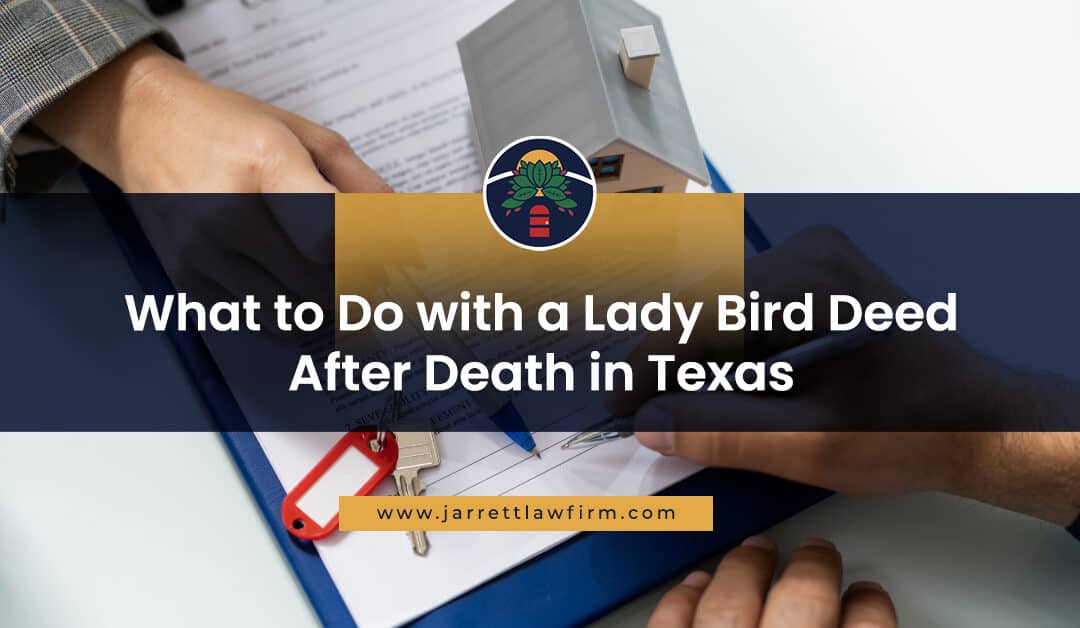When a loved one passes and leaves behind a Lady Bird Deed, you might wonder what comes next. Handling this type of deed, officially known as an Enhanced Life Estate Deed, can feel overwhelming at first. You need to know what to do with a Lady Bird deed after a death in Texas.
If you’re managing a property left through a Lady Bird Deed, you might feel uncertain about the next steps. This unique deed offers significant advantages, such as probate avoidance and tax benefits, but after the original owner’s death, you need to take specific actions.
We’ll explore what happens to the property, how to handle the legal side, and what it means for the designated beneficiary. By understanding these steps, you can ensure a smooth transition without unnecessary complications. Let’s break it down.
How Does an Enhanced Life Estate Deed Work in Texas?
Understanding the Role of the Life Tenant (Property Owner Before Death)
When the original property owner creates a Lady Bird Deed, also known as an enhanced life estate deed) they become the life tenant. They retain full control over the real property during their lifetime.
They can sell, mortgage, or transfer the property without needing consent from the remainder beneficiaries (the person(s) receiving the property after the property owner’s death). This flexibility is a key advantage of an enhanced life estate deed, allowing the property owner to maintain autonomy.
What Happens After the Life Tenant’s Death?
After the life tenant passes away, the property automatically transfers to you, the remainderman, without the need to go through probate court. However, keep in mind that the primary beneficiary inherits before any alternate beneficiary, provided they survive the decedent by at least 120 hours.
The property transfer is immediate, but you’ll need to file an affidavit of death and possibly a death certificate with county records to officially update ownership.
This streamlined process is why Lady Bird Deeds are valued—they help avoid probate and any delays tied to it.

Your Rights and Responsibilities as the Remainderman
As the new property owner, you now hold a full ownership interest. It’s important to know that:
Any legal document or title insurance changes need to be addressed soon after the life tenant’s death.
There could also be potential tax implications depending on when you sell or transfer the property. One key benefit is the step-up in basis, which can reduce the capital gains tax you may owe if you sell the property.
Medicaid Estate Recovery Considerations
Another major advantage of a Lady Bird Deed is protection from Medicaid estate recovery. Since the property wasn’t part of the life tenant’s probate estate, Medicaid can’t claim it for reimbursement of benefits.
This means the property remains protected, ensuring the intended beneficiaries receive the full value of the estate plan.
What To Do Next
Now that you understand how the property transfer works, it’s crucial to consult with a real estate attorney to ensure you meet all legal requirements.
Filing the proper documents in public records is key to finalizing the transfer and ensuring the property is officially yours.
How Do I File and Finalize the Property Transfer In Texas?
Gathering Essential Documents
After the life tenant’s death, the first step in finalizing the property transfer is gathering the necessary documents. You’ll need the following:
- Death certificate to prove the original property owner’s passing
- A property transfer affidavit
- There is a filing fee of around $40. Most county clerks will not accept a personal check.
These documents help to verify your ownership interest as the remainder beneficiary.
File the Affidavit of Death
Once you have the death certificate, you’ll file the affidavit of death with the county clerk where the property is located. This legal document confirms the life tenant’s death and ensures the property transfer is recorded in public records.
Keep in mind that this step is essential to avoid any issues with title insurance and the probate court.
If you’re ready to finalize your property deed transfer and want to avoid potential issues, contact us today at Jarrett Law in Houston. Call us at 832-831-0833 to schedule your consultation.

How to Complete the Affidavit of Death
Instructions for Filling Out the Affidavit of Death
The affidavit of death is a form. You can see instructions and an example form here.Use this form when the property owner who created the enhanced life estate deed passes away.
As the named beneficiary, filing this affidavit allows you to claim legal ownership of the property. Without a properly filed form, you cannot do any of the following:
- Sell the property
- Mortgage the property
- Obtain property tax exemptions
Steps to Complete the Form
- Personal Information: Enter your full name as the affiant who is filling out and signing the form.
- Legal Description of the Property: Input the legal description exactly as it appears on the original transfer on death deed. Ensure accuracy, and consult a lawyer if uncertain.
- Details of the Transfer on Death Deed: Fill in the name of the decedent (person who created the transfer on death deed), the date the deed was filed, and the county. Include volume and page numbers if available.
- Information About the Decedent’s Death: Record the date and place (city, county, state) of the decedent’s death in the form.
Finalizing the Process
- Sign the affidavit in front of a notary. Do not sign or date it beforehand.
- Leave the acknowledgment section for the notary to complete.
- In the “After Recording” section, provide your name and address as the beneficiary who now owns the property.
Filing the Affidavit
Go to the county clerk’s office where the property is located. Bring with you the following:
- The original affidavit and a copy
- Your identification
- The filing fee
- Texas Property Code Section. 11.003, any document transferring real property in Texas must include the mailing address of each person receiving the property. This can be written in the document itself or in a separate paper signed by the grantor or grantee. If the address isn’t provided, a penalty fee of $25 or twice the normal recording fee (whichever is higher) must be paid. If you don’t include the address, the transfer between the parties is still valid. Once the county clerk accepts and files the document, it’s presumed the requirements are met.
The Harris County Clerk’s office cannot accept electronically submitted Real Property documents except through their e-recording system. To set up e-recording with Real Property, you must first choose a vendor and verify that the chosen vendor will submit documents.
All of the documents they receive must go through an eRecord Provider who currently submits to Harris County. Find a list of their vendors here.
Updating the Deed
With a Lady Bird Deed, the property automatically transfers to you without needing a new deed. However, updating the public records and ensuring the legal description of the property is accurate will protect your future ownership.
If the original Lady Bird Deed is unclear or incomplete, consult a real estate attorney to avoid any complications.
Addressing Potential Tax Implications
Before transferring the property title completely, it’s wise to consider any potential tax implications. Depending on the property’s value and its stepped-up basis, selling the property might impact your tax obligations.
Consult your real estate lawyer to ensure you understand how this affects your financial situation, especially if you’re planning to sell the real property.
Finalizing the Transfer
After filing all necessary documents and addressing legal requirements, you’ll officially own the property.
The property transfer is complete, and you’ve successfully avoided probate. At this point, any liens or judgments against the property should be cleared. You’ll be the new property owner, ready to take full control of the asset.

Working With a Real Estate Attorney to Draw Up Your Affidavit
At Jarrett Law, we don’t rely on generic online forms. Instead, we craft each affidavit of death to fit your unique circumstances under Texas law, ensuring that your property transfer process is seamless and accurate.
Tailored Solutions for Your Situation
Whether you’re managing a Lady Bird Deed or any other type of property transfer, our real estate attorneys ensure your documents are legally sound and aligned with the most up-to-date regulations.
This protects your remainder interest and keeps your assets secure.
Avoiding Potential Pitfalls
Incorrectly filled documents can lead to delays or even disputes down the line. Our team at Jarrett Law takes care of every detail, from the legal description of the property to ensuring all necessary forms are filed correctly with the county clerk.
This personalized approach helps you avoid costly mistakes and unnecessary legal battles.

Get Experienced Guidance Every Step of the Way
Handling a property transfer can be complex, especially when navigating tax implications or the nuances of Texas law. Our attorneys provide guidance to help you understand every step, making sure the process goes smoothly and your ownership rights are secure.
Let’s Ensure Your Property Transfer is Done Right
If you’re ready to finalize your property deed transfer and want to avoid potential issues, contact us today. Call us at 832-831-0833 to schedule your consultation.
At Jarrett Law, we’re here to help you protect your assets and complete the process efficiently so you can enjoy the benefits of your inheritance.

